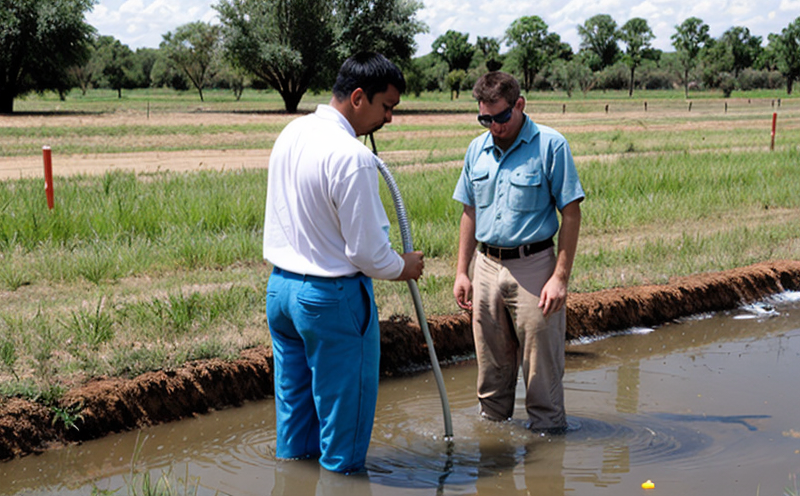EPA 200.7 Metals by ICP AES Test in Groundwater
The EPA Method 200.7 is a cornerstone of environmental testing, focusing on the determination of metals present in groundwater samples using Inductively Coupled Plasma Atomic Emission Spectrometry (ICP-AES). This method plays an essential role in ensuring that drinking water complies with the standards set by the Environmental Protection Agency for metal contaminants. The ICP-AES technique is highly sensitive and versatile, allowing for precise quantification of various metals including arsenic, cadmium, chromium, copper, lead, mercury, nickel, selenium, silver, and zinc.
Groundwater serves as a critical resource for drinking water supplies across the globe. Ensuring its purity is paramount to public health and environmental sustainability. EPA 200.7 addresses this need by providing stringent protocols for sample collection, preparation, and analysis that ensure reliable results. The method covers both the initial sampling process in the field and subsequent laboratory analysis, which includes digestion of samples with strong acids followed by a series of calibration steps to produce accurate readings.
The precision and accuracy of EPA 200.7 are critical for compliance purposes. Compliance officers need to rely on robust testing methods like this one when making decisions about water quality standards. For instance, in cases where local regulations exceed federal guidelines, it is necessary to use more stringent tests such as EPA 200.7 to ensure that all potential contaminants are accounted for.
The ICP-AES method used in EPA 200.7 allows for the simultaneous detection of multiple elements within a single run, making it efficient and cost-effective compared to separate analytical methods. This capability is particularly advantageous when dealing with complex matrices like those found in groundwater samples where numerous metals may coexist.
One key aspect of EPA 200.7 involves the digestion step, which typically uses nitric acid (HNO₃) and perchloric acid (HClO₄). This process breaks down organic compounds present in the sample matrix, ensuring that only metallic components are measured during analysis. After digestion, dilutions may be necessary depending on the concentration levels detected initially.
It is important to note that proper specimen preparation is crucial for accurate results under EPA 200.7 guidelines. Specimens must be collected according to specified procedures outlined in the method document itself or similar standards such as ISO methods if applicable. Proper handling and storage conditions also play a significant role in maintaining sample integrity throughout the testing process.
Once prepared, samples are analyzed using ICP-AES instrumentation. This involves introducing the sample solution into an argon plasma torch where elements within it become excited atoms emitting characteristic wavelengths of light corresponding to their respective atomic spectra. These emissions can then be captured and measured by photomultiplier tubes connected to the spectrometer.
The results from these measurements are compared against established calibration curves generated during method validation steps to determine the actual concentrations present in each sample. Reporting follows strict guidelines provided by EPA 200.7 ensuring transparency and comparability across different laboratories performing similar tests.
- Environmental and Sustainability Contributions:
- EPA 200.7 helps protect public health by identifying metal contaminants in groundwater, thereby preventing their spread into drinking water supplies.
- The method promotes sustainable resource management practices by ensuring that natural resources like groundwater are used responsibly without causing harm to ecosystems or human communities.
- By facilitating compliance with environmental regulations, EPA 200.7 contributes positively towards reducing pollution levels and promoting cleaner environments globally.
Benefits
The use of EPA Method 200.7 offers several benefits to organizations responsible for environmental monitoring and management:
- Comprehensive Analysis: The method allows simultaneous determination of multiple metals, providing a holistic view of potential contamination issues within groundwater samples.
- Precision & Accuracy: With its high sensitivity, EPA 200.7 ensures accurate measurement of even trace amounts of metal contaminants, crucial for meeting stringent regulatory requirements.
- Efficiency: By enabling simultaneous analysis of various metals in one run, this method reduces both time and cost associated with multiple individual analyses.
Eurolab Advantages
Eurolab’s expertise in EPA Method 200.7 stems from years of experience serving clients across diverse industries including manufacturing, agriculture, and municipal water supply systems.
We have invested significantly in state-of-the-art equipment to meet the rigorous demands imposed by this stringent testing protocol. Our facilities are equipped with advanced ICP-AES instruments capable of delivering precise quantitative data on metal concentrations down to parts per billion (ppb) levels.
Our team comprises highly trained professionals who possess deep knowledge and extensive experience in both field sampling techniques as well as laboratory-based analytical procedures associated with EPA 200.7 compliance. This combination ensures that every sample we receive undergoes thorough evaluation resulting in reliable outcomes.
In addition to technical proficiency, Eurolab adheres strictly to all relevant international standards including ISO/IEC 17025:2017 and EPA Method 200.7 itself ensuring traceability and consistency in our results.





